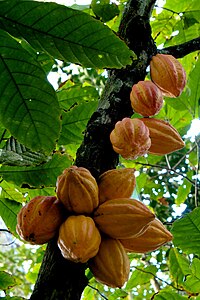 |
| The trunk of a Cocoa tree, picture from Wikipeadia |
Cocoa pods don't ripen all at the same time, they turn from green to orange, and have to be monitored carefully and harvested individually using knives on long poles. After the ripened pods are cut, the beans and pulp are removed and left to ferment either in piles covered in banana leaves or in wooden boxes. Organisms and bacteria like yeast produce acids and gases that partially break down proteins and sugars in the bean. After about a week, the beans are dark brown. From there, the beans are sold to factories. Then they are roasted to remove bacteria and break down acids that would make the beans taste bitter.
After roasting, the nibs of the beans are ground into a paste called 'mass' The mass then goes through a powerful press, where it is separated into butter and powder. The powder can then be further refined, and occasionally anti caking agents are added to make cocoa powder for baking. Sugar and other flavourings are added to make drinking chocolate powder. To make solid block chocolate, hot cocoa butter is mixed into coco powder and other flavourings.
We are surrounded by cocoa, it is used in just about every product on supermarket shelves. From block chocolates and baking powders, to biscuits and muesli bars dipped in it and ice creams, yogurts, slices, cereals, and drinks that use it as flavouring.
 |
| A dessert my class made in school using cocoa |
References; http://science.howstuffworks.com/innovation/edible-innovations/chocolate1.htm
http://nz.answers.yahoo.com/question/index;_ylt=AkC7IXQ3fxmdwPazK5dWdqHJZwx.;_ylv=3?qid=20130417115735AATM5xF
http://en.wikipedia.org/wiki/Theobroma_cacao
No comments:
Post a Comment